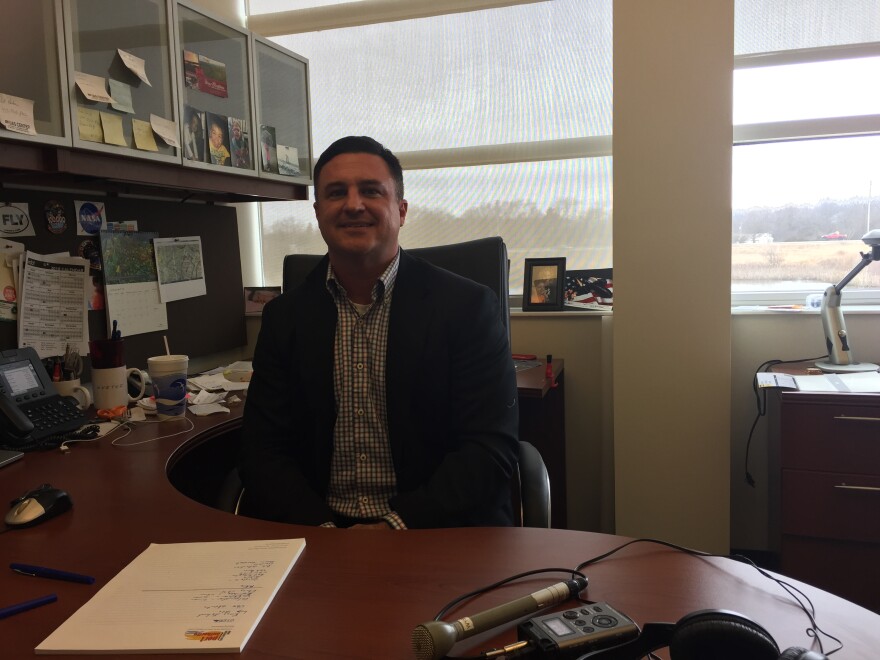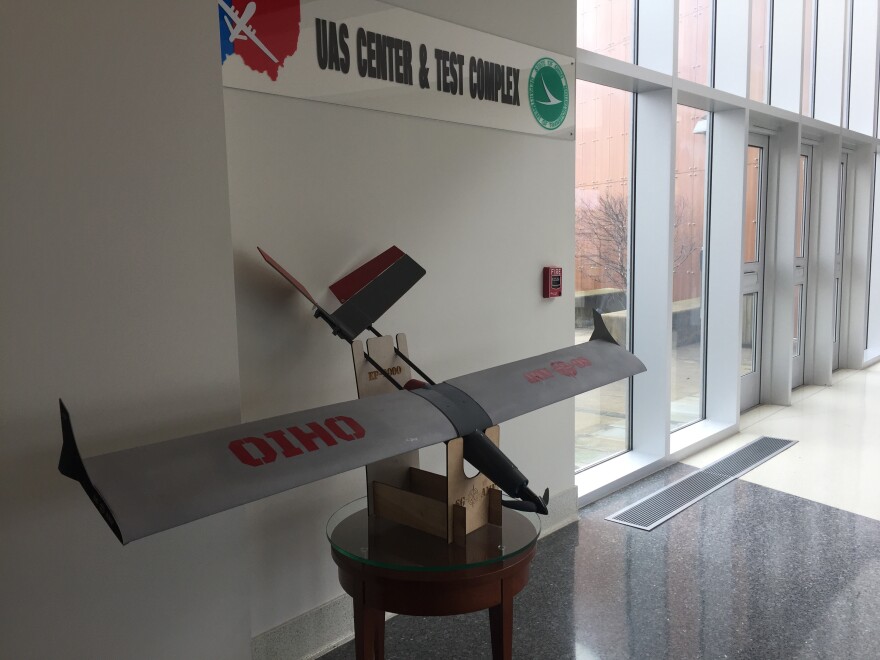Unmanned aerial drone technology is changing the way we live and work. And it’s not just Amazon and other corporate giants getting into the drone game. The multibillion-dollar industry is forecast to grow exponentially in coming years.
In this installment of our Scratch innovation series, we’ll hear about some of the surprising ways drones are altering –– even enhancing –– the human experience. And, WYSO’s Jerry Kenney reports as more drones take to the skies, the unmanned aerial systems are raising new questions for business, government and law enforcement.
It’s a bright, blustery day in Springfield when a small, black drone rises up off the ground to hover before me. Its design is simple, sleek, square and almost Frisbee-flat. This unmanned aerial vehicle, or UAV, has multiple cameras with facial-recognition capabilities.
“This is called a Skydio R1 is what it is, and it can lock onto our faces. It can distinguish the difference between you and me, and I'll kind of demonstrate how this thing works,” says David Gallagher, chief of staff at the Ohio/Indiana Unmanned Aerial Systems Center and Test Complex in Springfield.

Demonstrating some of the latest advances in drone technology, Gallagher moves around the parking lot. The drone pivots and follows him, automatically adjusting its position between him and surrounding objects.
“It's got 20 sensors on it that kind of monitor where the it's at, so it'll pick off the ground, will pick up light poles, will pick up the flagpole, pick up the side of the building,” he says. “As you can see, it'll keep following me. If I'm running on a bike path, and I think it'll try to go around me even here, too, if it sees my face.”

Watch a video of the Skydio in action.
Gallagher says the Skydio uses onboard cameras and other sensors to navigate so it can make quicker decisions than other drone models, which rely solely on GPS navigation. And he’s operating the drone from his cellphone.
“It's simple to do. Anyone can take it out of the box, download the app and start flying immediately,” Gallagher says.
Drones like this are available commercially and can cost several thousand dollars. They are often backed by slick marketing campaigns that feature athletes and adventurers documenting their conquests with the aid of their companion drones.
Tapping into drone technology
The UAS test complex in Springfield was created in 2013, when the state was competing for one of six designations by the Federal Aviation Administration as a UAS testing area. When Ohio was passed over as a potential site, Gov. John Kasich and then-Indiana Governor Mike Pence agreed to a regional collaboration aimed at developing drone technology.
The worldwide drone industry is expected to grow to $17 billion by the year 2024.
Gallagher says government agencies around the country are increasingly using drones for building and bridge inspections, road mapping, traffic analysis, even search and rescue missions. He says drones will take some jobs traditionally done by humans.
“People are going to use it for package delivery. You see paramedics using it for defibrillators and for bringing emergency objects to people in need,” he says. “Another area is human transportation, personal air vehicles. Google X is looking at this technology. Uber and Lyft are partnering with Bell Helicopter on a UAS. There is one out of Cincinnati called Workhorse Group, they have their own personal air vehicle.
“We [the Ohio Department of Transportation] does flight operations for other agencies,” Gallagher says. “We've done operations for EPA Ohio Peace Officers Training Academy, Department of Agriculture, Ohio Turn Park Association. So, the list goes on, and we also help small municipalities as well."
All this new technology is expected to create more than 100,000 jobs across the county over the next decade -- jobs in drone research, manufacturing, and operations.

To fill those jobs, many workers will require special training. And demand for this training appears to be growing in the Miami Valley.
At Sinclair Community College, Dr. Andrew Shepherd says he’s seeing double-digit growth each year in Sinclair’s Unmanned Aerial Systems credit and certificate programs.
Shepherd is the executive director and chief scientist with the program. He also serves as the managing editor of the Journal of Unmanned Aerial Systems.
There is, he says, “a lot of excitement as the industry continues to grow. A lot of students have moved on into positions now. Several started their own startup companies and it's a great time to get into the business.”
Drone technology is developing fast. Shepherd says, in some cases, it’s outpacing the federal and state regulations experts say are needed to allow the industry to move forward safely.
Shepherd says the FAA recently released long-awaited regulations governing commercial drones, but more will be are needed.
“We've been fortunate in the last few years the FAA has come out with the regulations allowing UAS to operate in the national airspace system more commonly for commercial purposes,” he says. “But, there's more regulations to follow, and so sometimes you're kind of doing informed guessing of where you think that will be heading and how long it will take to get there, and so far we've done pretty good.”
Yet, it’s likely there’s more guesswork ahead. As more governments, businesses and consumers take to the skies with their own unmanned aerial vehicles and the market for drone technology grows, so does the potential for accidents, says Shepherd.
Safety in the skies
Beavercreek resident RJ McKay knows something of the potential dangers a drone-filled sky could pose after he experienced a close call with a drone in 2016.
“Well, I was in the driveway talking with my fiancé and my mom, and lo and behold a drone dropped out of the sky,” McKay says. “All of a sudden there was this big ruckus, kind of in the top of a 40-foot pine tree and we thought it was a couple of squirrels fighting.”
Realizing it was a drone, McKay picked it up. When the rotors started turning again, he disabled it by pulling on some wires, he says.
“We were actually only about 30 feet [away],” he says. “So when you look at the statistical odds of things dropping out of the sky and near misses, I would call 30 feet a near miss. I mean, I hope that it's not going to become usual that they drop out of the sky and crash into property.”
McKay contacted the police, but he says they seemed unsure of how to handle the situation. Authorities eventually took custody of the drone.
Several days later, the drone's owner knocked at McKay’s door, asking whether he had seen it. McKay told him where to find it.
He also found a website where he could register his property as a drone no-fly zone.
Dozens more domestic drone accidents have been recorded in the last few years.
In the last few years, FAA officials have more firmly established regulations and protocols. The agency also requires registration for drones, depending on their size, weight, use and capability.
And as recently as January, Ohio Attorney General Mike DeWine said the state would offer police officers advanced courses on investigating UAS-related complaints.
Officials have also issued guidelines for law enforcement’s use of drones to investigate crime scenes and traffic accidents, missing person cases, SWAT operations and active-shooter incidents.
Looking to the future
David Gallagher says the next phase of drone development includes the so-called ground-based detect and avoid systems that the Ohio Department of Transportation is developing with the Air Force Research Laboratory at Wright-Patterson Air Force Base.
He says the technology will allow drones to fly farther, beyond an operator's line of sight -- a practice that is currently banned -- ushering in an era where manned and unmanned aircrafts can coexist in the skies.
“We've got a rich history of aviation and this new ground-based detect and avoid system is going to help spur UAS technologies in this region of the United States," he says. "That's good for jobs and the economy for the Dayton area, the birthplace of flight.”
---

About the Series:
A century ago, Dayton helped drive the global economy with inventions that changed the world – think, the airplane, the cash register, pop-top cans, the self-starting engine. In our spring series Scratch, WYSO explores some of the people and ideas that could impact life and the economy in the Miami Valley and beyond. The series was inspired by a simple question: where is Dayton’s famous spirit of invention still alive and well in the Miami Valley? And, who benefits?
Learn more, and add your voice, by clicking here.



